Related Research Articles

1998 WW31, is a non-resonant trans-Neptunian object and binary system from the Kuiper belt located in the outermost region of the Solar System, approximately 148 kilometers (92 miles) in diameter. It was first observed on 18 November 1998, by American astronomer Marc Buie and Robert Millis at the Kitt Peak National Observatory in Arizona, United States. In December 2000, a minor-planet moon, designated S/2000 (1998 WW31) 1 with a diameter of 123 kilometers (76 miles), was discovered in its orbit. After Charon in 1978, it was the first of nearly 100 satellites since discovered in the outer Solar System.
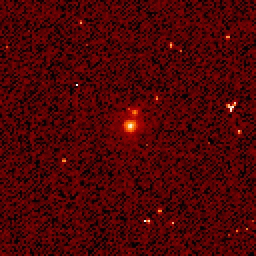
47171 Lempo, or as a binary (47171) Lempo–Hiisi (also known as 1999 TC36), is a trans-Neptunian object and trinary system from the Kuiper belt, located in the outermost regions of the Solar System. It was discovered on 1 October 1999, by American astronomers Eric Rubenstein and Louis-Gregory Strolger during an observing run at Kitt Peak National Observatory in Arizona, United States. Rubenstein was searching images taken by Strolger as part of their Nearby Galaxies Supernova Search project. It is classified as a plutino with a 2:3 mean-motion resonance with Neptune and is among the brighter TNOs. It reached perihelion in July 2015. This minor planet was named after Lempo from Finnish mythology.

(55565) 2002 AW197 (provisional designation 2002 AW197) is a classical, non-resonant trans-Neptunian object from the Kuiper belt in the outermost region of the Solar System, also known as a cubewano. With a likely diameter of at least 700 kilometers (430 miles), it is approximately tied with 2002 MS4 and 2013 FY27 (to within measurement uncertainties) as the largest unnamed object in the Solar System. It was discovered at Palomar Observatory in 2002.
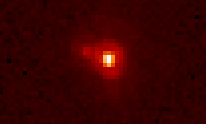
(55637) 2002 UX25 (provisional designation 2002 UX25) is a trans-Neptunian object that orbits the Sun in the Kuiper belt beyond Neptune. It briefly garnered scientific attention when it was found to have an unexpectedly low density of about 0.82 g/cm3.

58534 Logos, or as a binary system (58534) Logos-Zoe, is a trans-Neptunian object and binary system from the classical Kuiper belt, approximately 77 kilometers (48 miles) in diameter. The bright cubewano belongs to the cold population and has a 66-kilometer sized companion named Zoe. The system mass is (4.58±0.07)×1017 kg.

79360 Sila–Nunam (provisional designation 1997 CS29) is a cold classical Kuiper belt object (cubewano) and binary system made up of components of almost equal size, called Sila and Nunam, orbiting beyond Neptune in the Solar System. The name of the system is the combined names of the two bodies, Sila and Nunam.
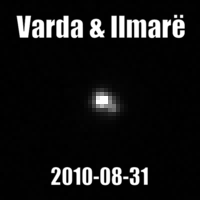
174567 Varda (provisional designation 2003 MW12) is a binary trans-Neptunian planetoid of the resonant hot classical population of the Kuiper belt, located in the outermost region of the Solar System. Its moon, Ilmarë, was discovered in 2009.

(84922) 2003 VS2 is a trans-Neptunian object discovered by the Near Earth Asteroid Tracking program on 14 November 2003. Like Pluto, it is in a 2:3 orbital resonance with Neptune and is thus a plutino. Analysis of light-curve suggests that it is not a dwarf planet.
(24835) 1995 SM55 (provisional designation 1995 SM55) is a trans-Neptunian object and member of the Haumea family that resides in the Kuiper belt, located in the outermost region of the Solar System. It was discovered on 19 September 1995, by American astronomer Nichole Danzl of the Spacewatch program at Kitt Peak National Observatory near Tucson, Arizona, in the United States. It measures approximately 200 kilometers in diameter and was the second-brightest known object in the Kuiper belt, after Pluto, until 1996 TO66 was discovered.

Salacia is a large trans-Neptunian object in the Kuiper belt, approximately 850 km (530 mi) in diameter. It was discovered on 22 September 2004, by American astronomers Henry Roe, Michael Brown and Kristina Barkume at the Palomar Observatory in California, United States. Salacia orbits the Sun at an average distance that is slightly greater than that of Pluto. It was named after the Roman goddess Salacia and has a single known moon, Actaea.

42355 Typhon (; provisional designation 2002 CR46) is a scattered disc object that was discovered on February 5, 2002, by the NEAT program. It measures 162±7 km in diameter, and is named after Typhon, a monster in Greek mythology.
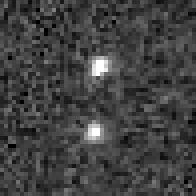
88611 Teharonhiawako (provisional designation 2001 QT197) is a trans-Neptunian object and a member of the cold classical Kuiper belt, measuring about 220 km in diameter. It is a binary object, with a large companion named Sawiskera (formally designated (88611) Teharonhiawako I Sawiskera), which at 126 km in diameter is about two-thirds the size of its primary. The two components together are known as the Teharonhiawako–Sawiskera binary system.

229762 Gǃkúnǁʼhòmdímà (provisional designation 2007 UK126) is a trans-Neptunian object and binary system from the extended scattered disc, located in the outermost region of the Solar System. It was discovered on 19 October 2007 by American astronomers Megan Schwamb, Michael Brown, and David Rabinowitz at the Palomar Observatory in California and measures approximately 600 kilometers (400 miles) in diameter. This medium-sized TNO appears to be representative of a class of mid-sized objects under approximately 1000 km that have not collapsed into fully solid bodies. Its 100-kilometer moon was discovered by Keith Noll, Will Grundy, and colleagues with the Hubble Space Telescope in 2008, and named Gǃòʼé ǃHú.

(455502) 2003 UZ413 (provisional designation 2003 UZ413) is a trans-Neptunian object (TNO) with an absolute magnitude of 4.38. It is in a 2:3 orbital resonance with Neptune, thus it is classified as a plutino. There are indications it may be dense enough to be a dwarf planet. It was given the minor planet number 455502 on 22 February 2016.

66652 Borasisi, or as a binary (66652) Borasisi-Pabu, is a binary classical Kuiper belt object. It was discovered in September 1999 by Chad Trujillo, Jane X. Luu and David C. Jewitt and identified as a binary in 2003 by K. Noll and colleagues using the Hubble Space Telescope.

Actaea, officially (120347)Salacia I Actaea, is a natural satellite of the classical Kuiper belt planetoid 120347 Salacia. Its diameter is estimated 300 km (190 mi), which is approximately one-third the diameter of Salacia; thus, Salacia and Actaea are viewed by William Grundy et al. to be a binary system. Assuming that the following size estimates are correct, Actaea is about the sixth-biggest known moon of a trans-Neptunian object, after Charon (1212 km), Dysnomia (700 km), Vanth (443 km), Ilmarë (326 km) and Hiʻiaka (320 km), but possibly also Hiisi.

(612095) 1999 OJ4 (provisional designation 1999 OJ4) is a trans-Neptunian object and binary system from the classical Kuiper belt, located in the outermost region of the Solar System. The bright cubewano belongs to the cold population and measures approximately 75 kilometers (47 miles) in diameter. It was first observed at Mauna Kea Observatory on 18 July 1999. Discovered in 2005, its minor-planet moon is just 3 kilometers smaller than its primary and has an orbital period of 84 days.

(524366) 2001 XR254, provisional designation 2001 XR254, is a trans-Neptunian object and binary system from the classical Kuiper belt, located in the outermost region of the Solar System. The cubewano belongs to the cold population and measures approximately 171 kilometers (110 miles). It was first observed on 10 December 2001, by astronomers at the Mauna Kea Observatory, Hawaii. Its 140-kilometer sized companion was discovered by the Hubble Space Telescope in June 2006.

(275809) 2001 QY297 is a trans-Neptunian object from the classical Kuiper belt, located in the outermost region of the Solar System. The binary classical Kuiper belt object belongs to the cold population.
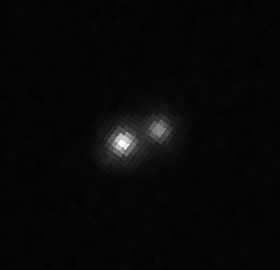
469705 ǂKá̦gára (provisional designation 2005 EF298) is a trans-Neptunian object and binary system of the core Kuiper belt, located in the outermost region of the Solar System. It was discovered on 11 March 2005 by American astronomer Marc Buie at the Kitt Peak Observatory in Arizona. The primary body measures around 140 kilometers (90 miles) in diameter. Its 120-kilometer (75-mile) companion ǃHãunu was discovered with the Hubble Space Telescope in 2009. The ǂKá̦gára–ǃHãunu system is currently undergoing mutual occultation and eclipsing events in which one body casts a shadow on or obstructs the view of the other as seen from Earth.
References
- 1 2 3 "508869 (2002 VT130)". Minor Planet Center. Retrieved 13 January 2020.
- 1 2 Marsden, Brian G. (3 December 2002). "MPEC 2002-X10: 2002 VR130, 2002 VS130, 2002 VT130, 2002 VU130". IAU Minor Planet Center. Harvard-Smithsonian Center for Astrophysics. Retrieved 14 May 2012.
- 1 2 3 "JPL Small-Body Database Browser: 508869 (2002 VT130)" (2017-03-29 last obs.). Jet Propulsion Laboratory . Retrieved 13 January 2020.
- 1 2 3 4 5 Johnston, Wm. Robert (27 May 2019). "Asteroids with Satellites Database – (508869) 2002 VT130". Johnston's Archive. Retrieved 13 January 2020.
- ↑ Marc W. Buie. "Orbit Fit and Astrometric record for 508869". SwRI (Space Science Department). Retrieved 18 February 2018.
- ↑ Brown, Mike. "How many dwarf planets are there in the Solar System" . Retrieved 18 February 2018.
- 1 2 3 4 Vilenius, E.; Kiss, C.; Mommert, M.; et al. (2014). ""TNOs are Cool": A survey of the trans-Neptunian region X. Analysis of classical Kuiper belt objects from Herschel and Spitzer observations". Astronomy & Astrophysics. 564: A35. arXiv: 1403.6309 . Bibcode:2014A&A...564A..35V. doi:10.1051/0004-6361/201322416. S2CID 118513049.
- 1 2 Grundy, W.M.; Noll, K.S.; Roe, H.G.; Buie, M.W.; Porter, S.B.; Parker, A.H.; Nesvorný, D.; Levison, H.F.; Benecchi, S.D.; Stephens, D.C.; Trujillo, C.A. (December 2019). "Mutual orbit orientations of transneptunian binaries". Icarus. 334: 62–78. doi:10.1016/j.icarus.2019.03.035.
- ↑ A. Thirouin; K.S. Noll; J.L. Ortiz; N. Morales (2014). "Rotational properties of the binary and non-binary populations in the trans-Neptunian belt". Astronomy & Astrophysics. 569: A3. arXiv: 1407.1214 . Bibcode:2014DPS....4642109T. doi:10.1051/0004-6361/201423567. S2CID 119244456.